Learning from the Tortoise
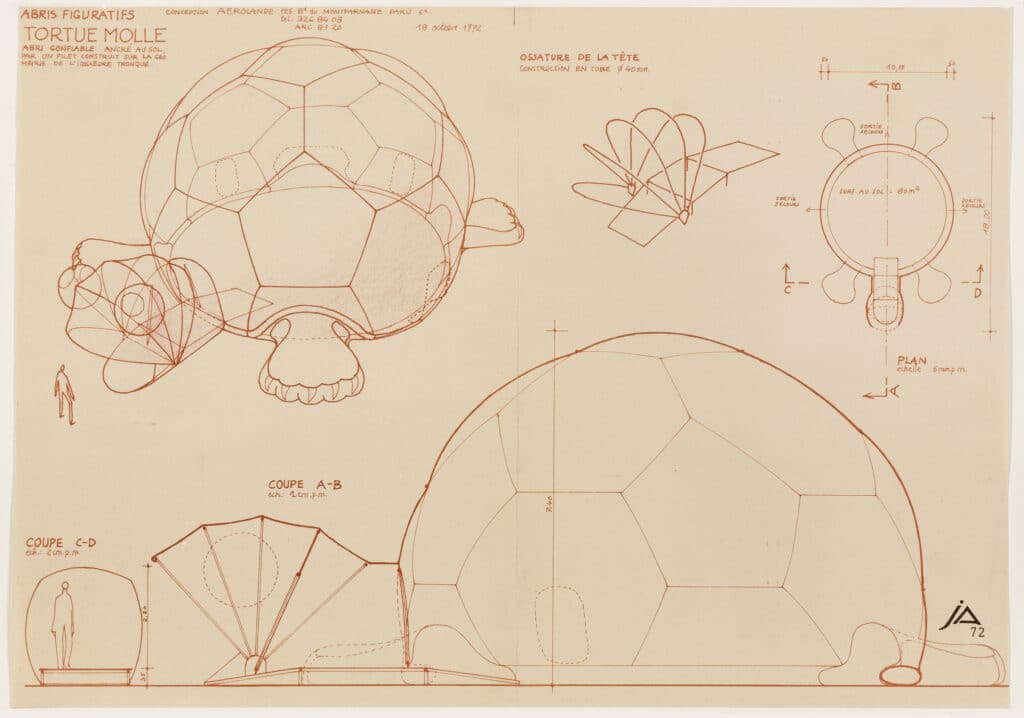
I.
The tortoise is certainly slow, but in the ancient fable it arrives sooner than the hare – or according to the even older paradox of Zeno it always arrives before the mighty runner Achilles. Slowness is usually seen as a negative characteristic, lacking the vibrancy of speed. But everything about the tortoise suggests that it proceeds at an altogether other pace from ourselves. It can grow to be older than almost any other animal, up to 200 years. Indeed, the tortoise is one of the oldest animals on earth, existing since its ancestors emerged from the sea in the age of the dinosaurs, 250 million years ago. Do tortoises even acknowledge our existence, as we speed by? Might they have anything to tell us?
The tortoise has a very small brain and – supposedly – no capacity for emotion, learning or memory, yet it can, by multiplying many simple operations, perform more complex tasks. Like the snail, and many sea creatures such as molluscs and crustaceans, it carries its house on its back and retreats inside for hibernation or protection. Its shell is a memory of life long ago in the sea. The upper shell, or carapace, integrates what in other animals would be ribs and also nerves and blood vessels, into a kind of endoskeleton. This is matched by another shell under the belly, known as the plastron. The two join together to form a continuous surface. A section through the hard elements of a tortoise reveals an intriguing relationship between the fixed form of the carapace and plastron, and the moving legs, head and tail, a kind of mobile architecture composed of the wonderful dome and the rather unlikely moving parts. There are aspects of the tortoise, whether as form, structure, character or metaphor which might make one begin to wonder about a source for architecture.
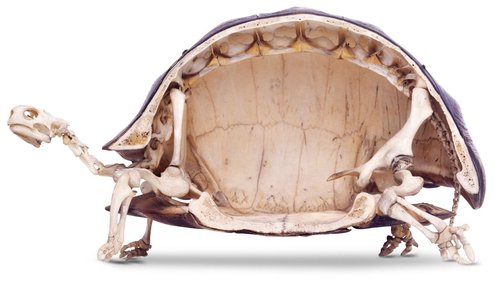
A drawing, above, by Jean Aubert, from 1972, proposes an inflatable building, a tortue molle, as part of a series of abris figuratifs, or figurative shelters. The French word tortue can imply either tortoise or turtle, belonging to land or sea. The turtle swims elegantly in its natural environment; the tortoise has never quite fully adapted to its move onto land. For convenience, and out of affection for a certain slow and retiring personality rather than any zoological correctness, I will stick with the classification of tortoise. Other shelters proposed by Aubert include a caterpillar, illustrated with an Alice in Wonderland-like girl; various jellyfish; and an iguana (i.e., creatures from the primitive end of the natural world, with simple, easily identified forms). The tortoise in Aubert’s drawing is shown in axonometric and elevation, the body consisting of a dome ten metres in diameter and composed of regular pentagons. It is an inflatable building, with an airlock between the interior space and an entry through the open mouth in the head. Aubert’s hand-drawn proposal is simple, and slightly absurd in its combination of technical specification and oversized anatomy. The tortoise appears cheerful enough, perhaps intended for a fair or carnival, but was never constructed (although Aubert also made the model, below). A note on the drawing states that the concept is by Aérolande and gives an address in Paris’ sixth arrondissement. There is a clear contrast between what is inflatable, quick to erect, lightweight and consisting entirely of a thin membrane, and an actual tortoise – heavy, slow, dense. It is a slight enough architectural proposal, but the beginning of a testudinidal trail to be followed at an appropriately relaxed pace.
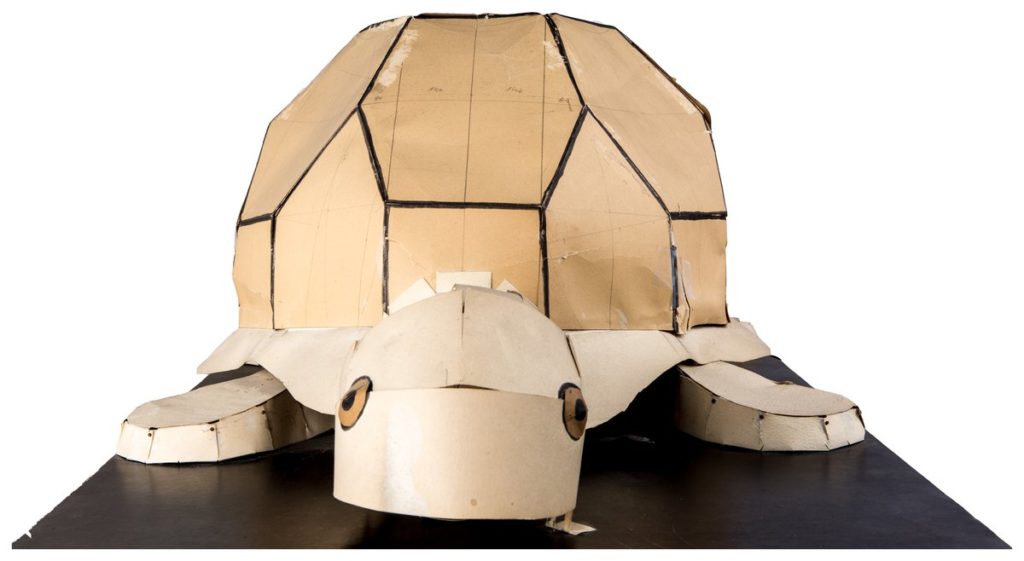
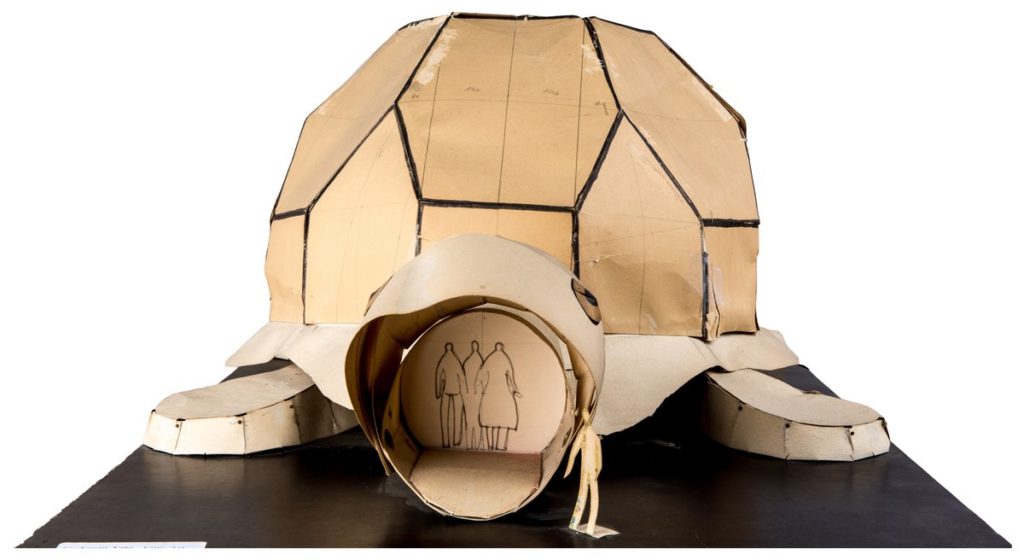
Jean Aubert was a French architect, born in 1935 in Mulhouse in Alsace. He was a student first in Strasbourg then in Paris at the École des Beaux-Arts. His final project (or cimaise) of 1967 was a proposal for a large mobile theatre with a structure of inflatable ribs and accommodating 5,000 spectators. It was, effectively, a geodesic dome, inevitably resembling, with its great shell divided into a pattern of geometrical forms, a giant tortoise. Already by this period Aubert was linked to two other architectural students: the Strasbourg-born Jean-Paul Jungmann and the Tunisian Antoine Stinco. Together they formed the group Aérolande for the design and construction of inflatable structures. Aubert’s inflatable tortoise is preceded by a drawing from 1969, a cartoon-like image of a motorway with speeding American automobiles. In the background are two vast slow and vaguely malignant creatures: a snail and a tortoise, the new animal-buildings that have slithered or crawled into the modern city.
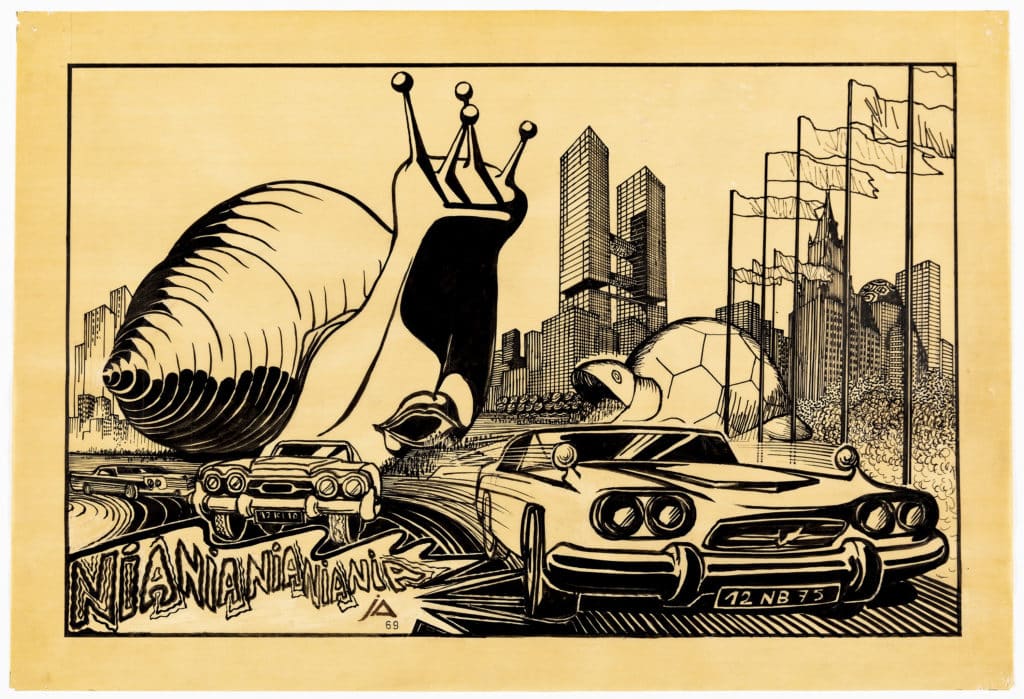
Aérolande were linked to the left-wing revolutionary theoretical group Utopie, which included the sociologists Jean Baudrillard and Catherine Cot, and the urban theorist and architect Hubert Tonka. This group was one of several thrown up in the feverish atmosphere of late-1960s France. Its aims were to question the large-scale urban planning of Paris, the growth of the French military-industrial complex, the production of unchangeable permanent buildings, and to investigate possible architectural alternatives. For a while Aérolande became the pneumatic architecture wing of the Utopie movement. Utopie produced an eponymous magazine, which published not only the theoretical propositions of Baudrillard and others, but also the architectural proposals of Aubert, Jungmann and Stinco. Jungmann had produced the remarkable Dyodon project, named for an actual fish which can inflate (Aérolande were fond of zoological sources). The resulting inflatable multi-storey habitation was based on a three-dimensional geometry but was adaptable to any terrain offering a sort of bourgeois lifestyle, yet it was fleeting, ephemeral. Inflatables were very much in fashion in the 1960s and were proposed as a potential alternative to the permanent, rectilinear, rather stuffy inheritance of French modernism, which determined the forms of French cities. Inflatable buildings, as already proposed by Buckminster Fuller, Birdair structures or Frei Otto were ephemeral, they could be quickly erected and removed, could be almost any shape, and could be used for mass gatherings such as concerts, meetings or shelter for large numbers of people. They appealed to the idea of a society in a state of rapid transition, and therefore also to the radical thinkers of Utopie.
The link between Aérolande and Utopie lasted only a few years. The members of Aérolande shared with Baudrillard a dislike of official art and architecture, but rather than hyper-reality and simulation theirs was a love of bandes desinées, street art, counter-culture. Moving at their own somewhat irregular pace, Aérolande adopted the tortoise as their logo. It was a curious choice for a group concerned with visionary projects and inflatables; the tortoise is considered meditative but is little known for its vision. The drawings of this group of individuals contain suggestions of a variety of sources: technical and constructional details, three-dimensional geometry, the great French and Belgian bandes dessinées, such as the immaculately drawn fantasies of Benoît Peeters and François Schuiten. From the 1970s to the early 90s Aubert and Jungmann in particular became devoted to large architectural and urban drawings produced by hand – slow, continually evolving, full of texture and tone, leaving in the signs of mistakes and rethinks – compared to the digital techniques that were beginning to transform the architectural drawing into a rapidly produced and impersonal product. A series of large-format magazines, L’ivre de Pierrres, were produced by Jean-Paul Jungmann and Hubert Tonka. L’ivre de Pierres, wrote the editors, ‘does not attempt to formulate a theory of the city but we aim to put into practice its poetry. An attempt to create a theory out of poetry would end up a paltry one’. This indicates a step aside from the big theories of Baudrillard and Utopie and an advance into a stranger and more lyrical territory.
II.
One morning a large parcel arrived in the post. Jean-Paul Jungmann, who lives in Bordeaux, had sent me the four volumes of L’ivre de Pierres (the fifth volume never made it into print). The magazines are remarkable for their oversize format and bold layouts. The issues illustrate large-scale projects such as Jungmann’s Future Ruin for Les Collines de Chaillot, with vast elements floating over Paris, and Aubert’s proposal for a series of extensive hydraulic gardens titled ‘Les Jardins de Outcq et le Palais des Thermes de Villette’. Such projects are displayed alongside late eighteenth-century revolutionary urban projects by Jean-Jacques Lequeu and Charles de Wailly and others, suggesting that these new visionary hand-drawn projects were linked back almost 200 years to an earlier period of French architecture – the period of architecture parlante, of an architecture that spoke directly to all. The contemporary techniques of the bandes dessinées could somehow encounter without obvious disjunction the delicate washes of that revolutionary period.
Familiar forms reappear. In Aubert’s grand hydraulic project, the tortoise makes a slight and mythical return, on a boat in a grove of trees. ‘The tortoise, why is he here, at the lowest location in the garden? Because he is the Tortuga the beast of Tartarus, the longest river on earth. He is not on a stone but on a prow, it is the ship of Charon…’. Aubert attempting to make an etymological link between the word tortue and the Greek word for the underworld, Tartarus. The tortoise emerges out of the aqueous depths of the underworld, from a past more mythical than geological. Aubert has moved some way from the light ephemeral world of the original tortue molle, from the free-thinking days of the student revolts, to a darker uneasy semi-mythical version of Paris.
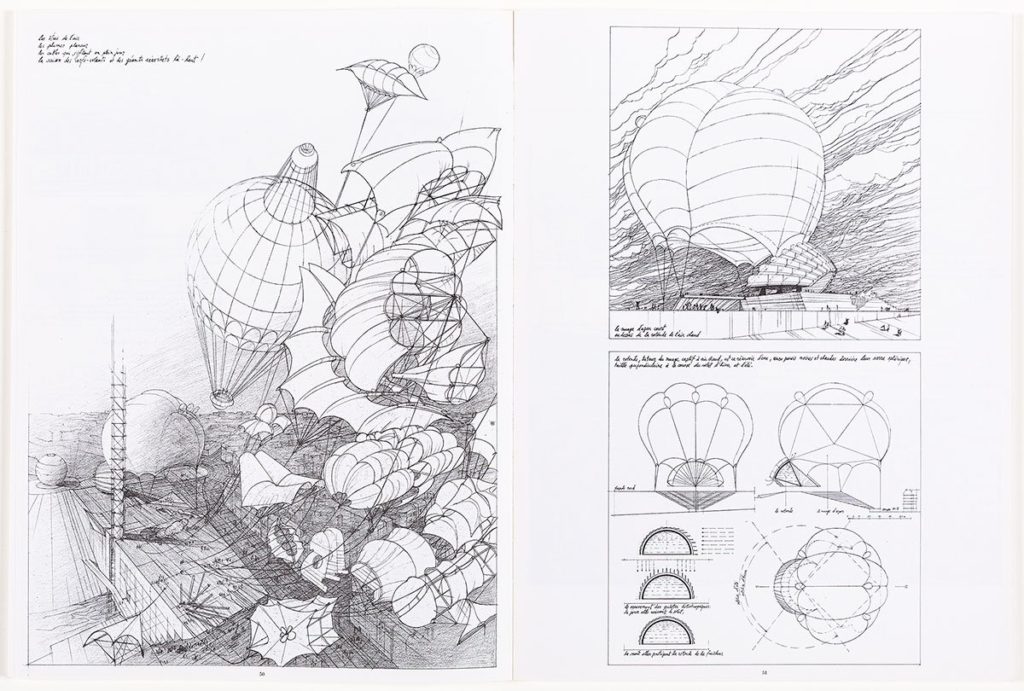
Aubert and Jungmann produced drawings of great elegance and individuality, but there is a certain irony that while their early projects were about the future, the later ones are increasingly concerned with the distant past. They produced other visionary projects, mainly in Paris – Aubert for Les Halles with the introduction of a contemporary Stonehenge, and Jungmann for La Place de la Concorde, with strange monumental forms. The tortoise had become for them symbolic of a drawing method, immaculate and carefully evolved renderings in green and blood-red pencil, and in the pigment of Terre de Sienne. In the 1980s Aubert produced several books on descriptive geometry in architecture, illustrated with his own remarkable drawings. These drawings, which parallel the work of the English writer Robin Evans, seem today to emerge from another period, which has now entirely vanished.
And then also – a small diversion on the tortoise trail – in L’ivre de Pierres 4 appears a project for lost landscapes of Paris by the Czech sculpture Ivan Theimer, with a drawing of a large tortoise carrying on its carapace a great rock, or in another drawing a classical building, emerging out of antiquity. The tortoise is following another of its traditional roles, carrying the weight of the world on its shell. Theimer remained true to his patient love of tortoises: he later produced the sculpture with a tortoise carrying a stele and others carrying people in his hometown Olomouc, in Moravia; the sculpture of two tortoises, mother and child, eating grapes in the place de Victoire in Bordeaux; the four tortoises carrying a mystic obelisk in the gardens in the gardens of the Élysée Palace; the two tortoises supporting a woman by the seaside in Follinica, Italy; and many others. But now suddenly there are too many tortoises, all no doubt wonderful but certainly too many, moving too fast. We need to slow down again.
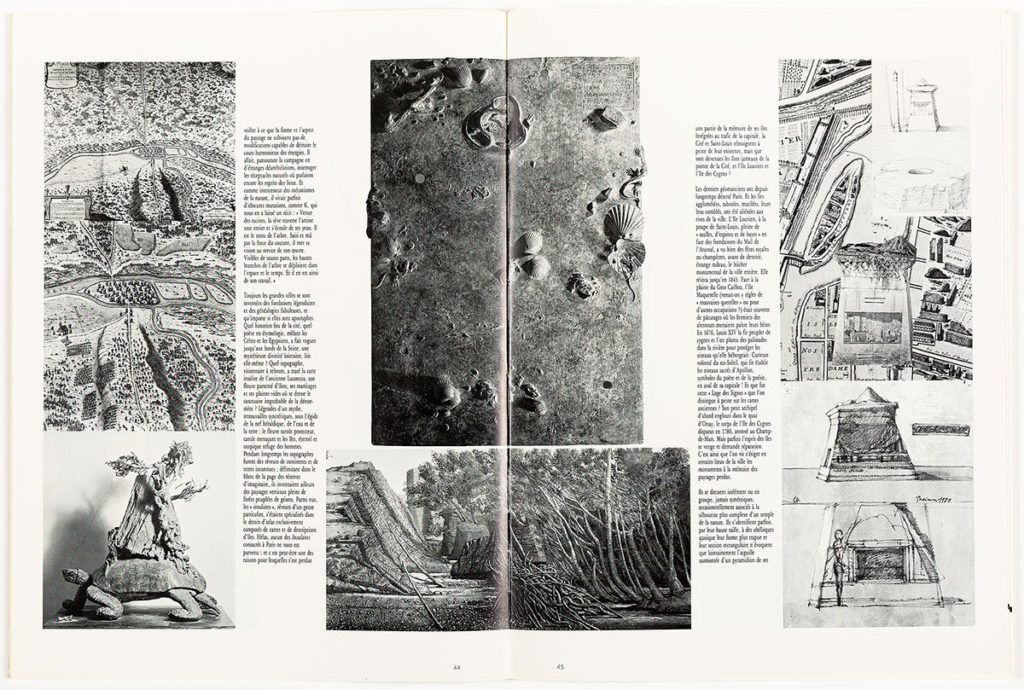
III.
In this rambling tale, I wonder about that rather direct derivation of architectural form from creatures, illustrated by Aubert’s inflatable tortoise? Buildings that imitate on a large scale the forms of animals have a long history. There are numerous houses that imitate tortoises and turtles – for instance the turtle building in the Gobi Desert (turtles in the desert – life is too short to ask why…) and another, much larger turtle building on an island near Java. There are many oversized puppies, cats, dinosaurs, fish and other creatures. Tomi Ungerer, the Alsace-born illustrator of both children’s books and sado-masochistic erotic drawings – an unusual combination – designed a kindergarten near Karlsruhe in the form of a cat, which was constructed. Many of these buildings are cute and frivolous, but there is also an undercurrent of more serious intent. Jean-Jacques Lequeu produced a detailed drawing of a stable in the form of a cow standing in a field and with a large urn placed on its head, raising no doubt the architectural standards for French cattle – if an example of architecture parlante this beast would no doubt moo, or rather meuh, in gallic tones.
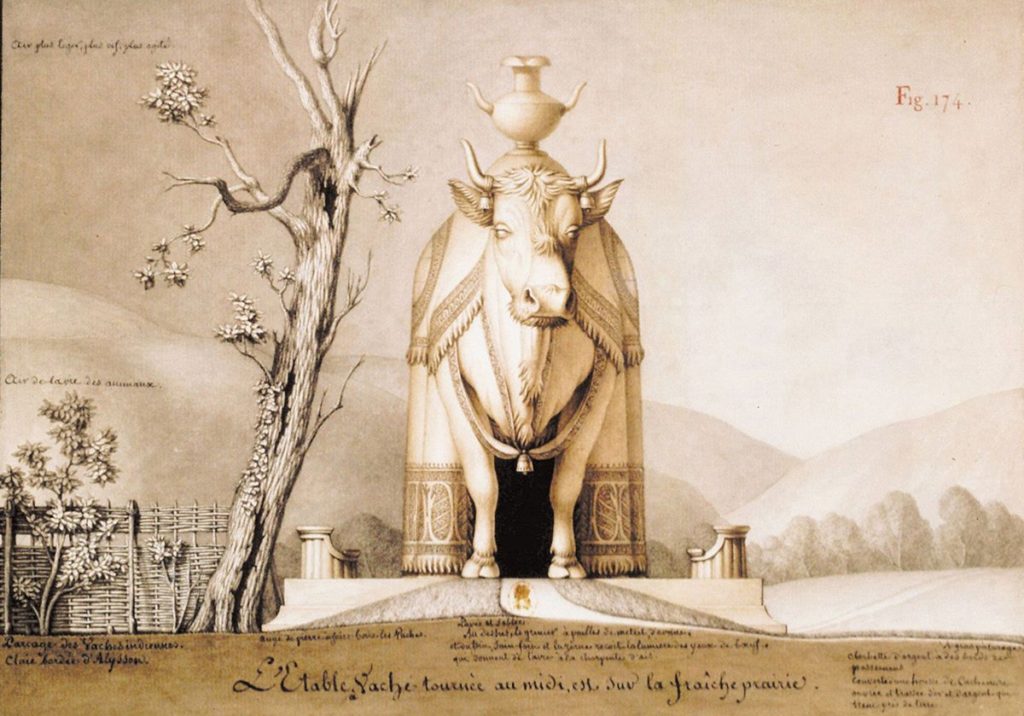
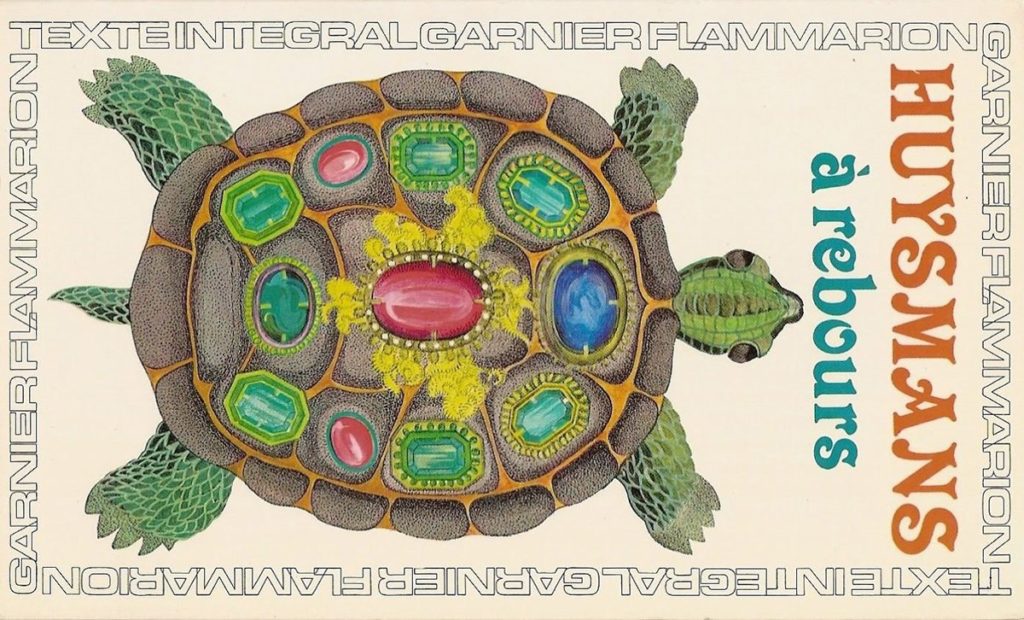
Then, in the 1960s, Robert Venturi and Denise Scott Brown based an entire theory of architecture on a large white duck building, constructed on Long Island in New York State in 1931 and used for selling ducks and duck eggs. Venturi and Scott Brown compared the sculptural form of the Duck, where symbolism and function are matched, to what they termed the Decorated Shed, where decoration is applied to an otherwise purely functional structure. Perhaps here one might recall an earlier category-crossing version of this theory, the decorated tortoise, as in Joris-Karl Huysman’s À rebours, in which the reclusive aesthete Jean des Esseintes sets gemstones into the shell of a tortoise, eventually crushing the creature under their weight. In a slippage of creature qualities Lequeu’s cow was a kind of Duck, with its form matching its function. And yet the soft tortoise of Aubert does not really qualify as a Duck, since its function – a play-space, a hall, an exhibition space – has nothing to do with tortoises.
The Aubert tortoise had a longer life than might have been originally anticipated. The soft tortoise reappeared briefly in 2018, three years after the death of Aubert, in an unrealised proposal by Jungmann and others for a pavilion for the 16th Venice Biennale. The tortoise was to house the documentation of 50 years, with the story of the inflatable from the events of 1968 and Utopie, up to current times, with contemporary inflatables such as Hans-Werner Müller’s Centre for the Humanitarian Reception of Immigrants on the Boulevard Ney. The giant tortoise was now to be inflated inside one of the classical Venetian pavilions, its body filling the entire interior space, as though it had now acquired a second shell of Venetian architecture, ‘its head poking out through the principal doorway, like a monumental emoji without significance, a playful and affirmative rupture in the order of things’. This tortoise has elements of architecture parlante, speaking directly to all of a certain lightness and airiness, subverting its solid classical shell. Here is also a memory of an earlier Venetian tortoise, sketched in chalk on blue paper by the Danish artist Melchior Lorck in 1555, a great tortoise hovering over the Venetian lagoon, freed from gravity, in the air rather than of air. It is as though this tortoise has sought to return from the land to its natural element, the sea, but has instead risen up into the sky.
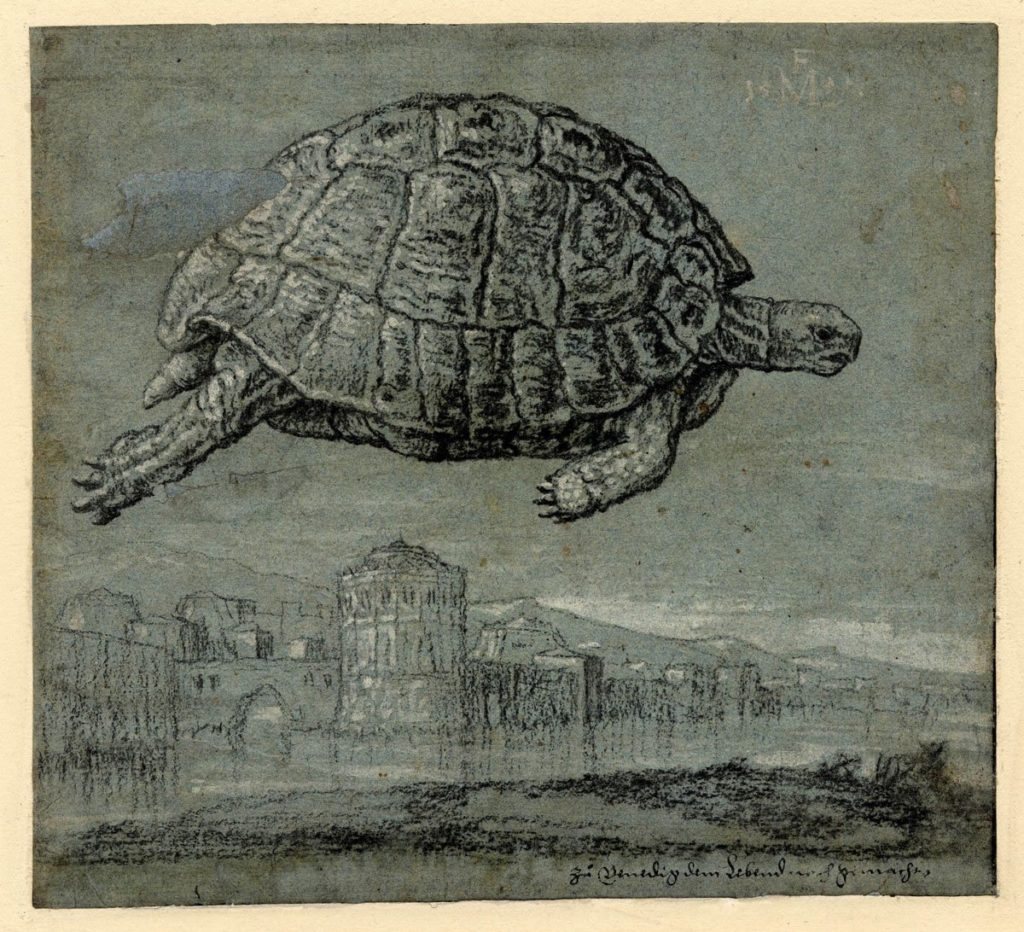
IV.
The tortoise stumbles through the story of Aérolande, pausing sometimes to retreat inside its shell to await more favourable times, with no great concern for what is happening around it. Pneumatic structures, revolutionary movements and French theory are all equally irrelevant to its long and quiet life. Was there ever any lesson to be learned from the tortoise? Was there something that we missed, because we were moving too fast, always trying to catch up with the creature on its leisurely path? As Lewis Carroll wrote in Alice’s Adventures in Wonderland, a book in which various creatures show themselves to be more aware than the human characters:
‘When we were little’, the Mock Turtle went on at last, more calmly, though still sobbing a little now and then, ‘we went to school in the sea. The master was an old turtle, we used to call him Tortoise…’
‘Why did you call him Tortoise, if he wasn’t one?’ Alice asked.
‘We called him Tortoise because he taught us,’ said the Mock Turtle angrily: ‘really you are very dull!’
Notes
- Many thanks to Jean-Paul Jungmann for his invaluable assistance with information on Aérolande.

– Elie Delamare-Debouteville